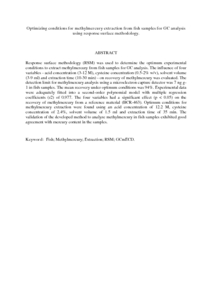Citation
P., Hajeb and Selamat, Jinap and Abu Bakar, Fatimah and Bakar, Jamilah
(2009)
Optimizing conditions for methylmercury extraction from fish samples for GC analysis using response surface methodology.
Food Additives & Contaminants: Part A, 26 (6).
pp. 829-838.
ISSN 1944-0049; ESSN: 1944-0057
Abstract
Response surface methodology (RSM) was used to determine the optimum experimental conditions to extract methylmercury from fish samples for GC analysis. The influence of four variables - acid concentration (3-12 M), cysteine concentration (0.5-2% w/v), solvent volume (3-9 ml) and extraction time (10-30 min) - on recovery of methylmercury was evaluated. The detection limit for methylmercury analysis using a microelectron capture detector was 7 ng g-1 in fish samples. The mean recovery under optimum conditions was 94%. Experimental data were adequately fitted into a second-order polynomial model with multiple regression coefficients (r2) of 0.977. The four variables had a significant effect (p < 0.05) on the recovery of methylmercury from a reference material (BCR-463). Optimum conditions for methylmercury extraction were found using an acid concentration of 12.2 M, cysteine concentration of 2.4%, solvent volume of 1.5 ml and extraction time of 35 min. The validation of the developed method to analyze methylmercury in fish samples exhibited good agreement with mercury content in the samples.
Download File
![[img]](http://psasir.upm.edu.my/15996/1.hassmallThumbnailVersion/Optimizing%20conditions%20for%20methylmercury%20extraction%20from%20fish%20samples%20for%20GC%20analysis%20using%20response%20surface%20methodology.pdf)  Preview |
|
PDF (Abstract)
Optimizing conditions for methylmercury extraction from fish samples for GC analysis using response surface methodology.pdf
Download (84kB)
| Preview
|
|
Additional Metadata
Actions (login required)
 |
View Item |

